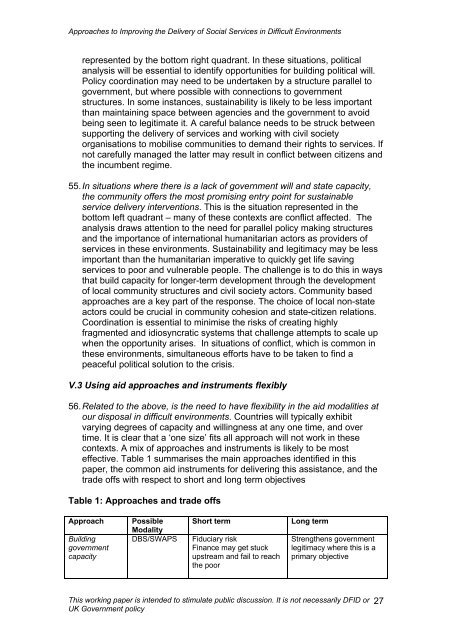Approaches to Improving the Delivery of Social Services in Difficult ...
Approaches to Improving the Delivery of Social Services in Difficult ...
Approaches to Improving the Delivery of Social Services in Difficult ...
Create successful ePaper yourself
Turn your PDF publications into a flip-book with our unique Google optimized e-Paper software.
<strong>Approaches</strong> <strong>to</strong> <strong>Improv<strong>in</strong>g</strong> <strong>the</strong> <strong>Delivery</strong> <strong>of</strong> <strong>Social</strong> <strong>Services</strong> <strong>in</strong> <strong>Difficult</strong> Environmentsrepresented by <strong>the</strong> bot<strong>to</strong>m right quadrant. In <strong>the</strong>se situations, politicalanalysis will be essential <strong>to</strong> identify opportunities for build<strong>in</strong>g political will.Policy coord<strong>in</strong>ation may need <strong>to</strong> be undertaken by a structure parallel <strong>to</strong>government, but where possible with connections <strong>to</strong> governmentstructures. In some <strong>in</strong>stances, susta<strong>in</strong>ability is likely <strong>to</strong> be less importantthan ma<strong>in</strong>ta<strong>in</strong><strong>in</strong>g space between agencies and <strong>the</strong> government <strong>to</strong> avoidbe<strong>in</strong>g seen <strong>to</strong> legitimate it. A careful balance needs <strong>to</strong> be struck betweensupport<strong>in</strong>g <strong>the</strong> delivery <strong>of</strong> services and work<strong>in</strong>g with civil societyorganisations <strong>to</strong> mobilise communities <strong>to</strong> demand <strong>the</strong>ir rights <strong>to</strong> services. Ifnot carefully managed <strong>the</strong> latter may result <strong>in</strong> conflict between citizens and<strong>the</strong> <strong>in</strong>cumbent regime.55. In situations where <strong>the</strong>re is a lack <strong>of</strong> government will and state capacity,<strong>the</strong> community <strong>of</strong>fers <strong>the</strong> most promis<strong>in</strong>g entry po<strong>in</strong>t for susta<strong>in</strong>ableservice delivery <strong>in</strong>terventions. This is <strong>the</strong> situation represented <strong>in</strong> <strong>the</strong>bot<strong>to</strong>m left quadrant – many <strong>of</strong> <strong>the</strong>se contexts are conflict affected. Theanalysis draws attention <strong>to</strong> <strong>the</strong> need for parallel policy mak<strong>in</strong>g structuresand <strong>the</strong> importance <strong>of</strong> <strong>in</strong>ternational humanitarian ac<strong>to</strong>rs as providers <strong>of</strong>services <strong>in</strong> <strong>the</strong>se environments. Susta<strong>in</strong>ability and legitimacy may be lessimportant than <strong>the</strong> humanitarian imperative <strong>to</strong> quickly get life sav<strong>in</strong>gservices <strong>to</strong> poor and vulnerable people. The challenge is <strong>to</strong> do this <strong>in</strong> waysthat build capacity for longer-term development through <strong>the</strong> developmen<strong>to</strong>f local community structures and civil society ac<strong>to</strong>rs. Community basedapproaches are a key part <strong>of</strong> <strong>the</strong> response. The choice <strong>of</strong> local non-stateac<strong>to</strong>rs could be crucial <strong>in</strong> community cohesion and state-citizen relations.Coord<strong>in</strong>ation is essential <strong>to</strong> m<strong>in</strong>imise <strong>the</strong> risks <strong>of</strong> creat<strong>in</strong>g highlyfragmented and idiosyncratic systems that challenge attempts <strong>to</strong> scale upwhen <strong>the</strong> opportunity arises. In situations <strong>of</strong> conflict, which is common <strong>in</strong><strong>the</strong>se environments, simultaneous efforts have <strong>to</strong> be taken <strong>to</strong> f<strong>in</strong>d apeaceful political solution <strong>to</strong> <strong>the</strong> crisis.V.3 Us<strong>in</strong>g aid approaches and <strong>in</strong>struments flexibly56. Related <strong>to</strong> <strong>the</strong> above, is <strong>the</strong> need <strong>to</strong> have flexibility <strong>in</strong> <strong>the</strong> aid modalities a<strong>to</strong>ur disposal <strong>in</strong> difficult environments. Countries will typically exhibitvary<strong>in</strong>g degrees <strong>of</strong> capacity and will<strong>in</strong>gness at any one time, and overtime. It is clear that a ‘one size’ fits all approach will not work <strong>in</strong> <strong>the</strong>secontexts. A mix <strong>of</strong> approaches and <strong>in</strong>struments is likely <strong>to</strong> be mosteffective. Table 1 summarises <strong>the</strong> ma<strong>in</strong> approaches identified <strong>in</strong> thispaper, <strong>the</strong> common aid <strong>in</strong>struments for deliver<strong>in</strong>g this assistance, and <strong>the</strong>trade <strong>of</strong>fs with respect <strong>to</strong> short and long term objectivesTable 1: <strong>Approaches</strong> and trade <strong>of</strong>fsApproachBuild<strong>in</strong>ggovernmentcapacityPossibleModalityDBS/SWAPSShort termFiduciary riskF<strong>in</strong>ance may get stuckupstream and fail <strong>to</strong> reach<strong>the</strong> poorLong termStreng<strong>the</strong>ns governmentlegitimacy where this is aprimary objectiveThis work<strong>in</strong>g paper is <strong>in</strong>tended <strong>to</strong> stimulate public discussion. It is not necessarily DFID orUK Government policy27
















